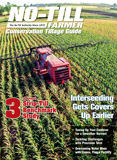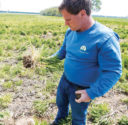Advertise Follow Us
No-Till Farmer

View Archived Issues
August 2016: Conservation Tillage Guide
Volume: 45
Edition: 8
Get full access NOW to the most comprehensive, powerful and easy-to-use online resource for no-tillage practices. Just one good idea pays for your subscription hundreds of times over.
Subscribe
-
Table of Contents
Table of Contents
Digital Subscribers enjoy full access to No-Till Farmer's premium content. A paid subscription is required in order to read these stories.Are you a Premium or Digital subscriber? You enjoy:
- Unlimited access to all digital content here
- Freedom to view No-Till Farmer on all your devices
- Gleaning years of knowledge from the world's largest online library dedicated to no-till practices
Are you a Print only subscriber? Easily upgrade your subscription today! For only $10 more on a one year option, you gain the benefits of both the print edition delivered to your door and unlimited access to thousands of online pages of no-till content.
What I've Learned from No-TillingRejuvenating Acres and Ramping Up Soil Productivity
No-till is just one component of the system Dan DeSutter is using to break up compaction, store water, increase organic matter and improve yields.Read MoreInterseeding Tools Get Cover Crops Off to Faster Start
No-tillers can avoid the mad rush to get cover crops seeded after harvest by planting them into standing cash crops.Read MorePrecise Nutrient, Cover Crop Use Cleans Up Chesapeake
Trey Hill shares what he’s learned from trying to reduce nitrogen leaching, managing inputs and battling slugs on his 10,000 no-till acres.Read More10 Tips to Make Combines a Well-Tuned No-Till Asset
Adjustments to sickles, flighting, sieves, stripper plates and other components can keep more grain in the tank and make harvest more efficient.Read MoreCommitting to Cover Crops Brings Added Benefits to No-Till
After seeing the changes cover crops made to one farm, the Eberhard family is going all in to take out weeds and secure and produce nutrients.Read MoreStrip-Till Operational Benchmark StudyDiversity of Methods Produce Strip-Till Stability and Flexibility
Increased adoption of cover crops and variable-rate fertilizing help strip-tillers maintain corn yields and increase soybean yields in 2015.Read MoreStrip-Till Operational Benchmark StudyStrip-Tilled Corn Acres, Soybean Yields Increase
The overall average of strip-tilled acres per farm grew by nearly 200, while average corn yields topped 190 and soybean yields jumped 4 bushels.Read MoreStrip-Till Operational Benchmark StudyCover Cropping, Twin-Row Strip-Till Continue to Rise
More than 50% of benchmark respondents utilize cover crops, while the percent of strip-tillers planting twin rows has more than doubled.Read MoreStrip-Till Operational Benchmark StudyBlending Fertilizer into the Berm, Variable-Rate Application Increase
Anhydrous and zinc applications decline, while more farmers applied monoammonium phosphate (MAP) and urea with strip-till rigs in 2015.Read MoreStrip-Till Operational Benchmark StudyShifting Preferences for Brand, Size and Setup of Strip-Till Rigs
Fewer strip-tillers used mole knives, while brand diversity and the number of row units increased.Read MoreNo-Till Evolution Begins with a First Step
After nearly going broke with heavy tillage and weathered soils, Johnny Hunter is staking his farming future on planting green.Read MoreOpening the Door to Change Sparks No-Tilling Success
Steve Tucker sees a profitable future for his no-till operation with a commitment to cropping diversity and keeping soils covered.Read MoreSupport, Training Keys to Curing Precision Pain Points
Five no-tillers and strip-tillers share their experiences on current challenges and goals to improve productivity with farm technology.Read MoreFarm Show Directory
Following are the farm shows that advertisers in this issue of No-Till Farmer Conservation Tillage Guide are exhibiting at from August through October. Booth numbers and locations are in parenthesesRead MoreNo-Till Notes: Improving Efficiency in Your No-Till Fertility
Take soil tests, select efficient fertilizer products and consider timing and placement to reduce nutrient loss and economically build up soil levels.Read More -
Featured Articles
Featured Articles
Strip-Till Operational Benchmark StudyDiversity of Methods Produce Strip-Till Stability and Flexibility
Increased adoption of cover crops and variable-rate fertilizing help strip-tillers maintain corn yields and increase soybean yields in 2015.Read MoreWhat I've Learned from No-TillingRejuvenating Acres and Ramping Up Soil Productivity
No-till is just one component of the system Dan DeSutter is using to break up compaction, store water, increase organic matter and improve yields.Read More - Digital Edition
- Online Extras
















